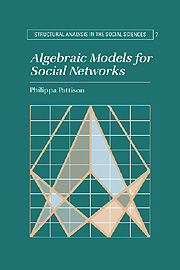Book contents
- Frontmatter
- Contents
- List of figures and tables
- Preface
- 1 Algebraic representations for complete social networks
- 2 Algebraic representations for local social networks
- 3 Comparing algebraic representations
- 4 Decompositions of network algebras
- 5 An analysis for complete and local networks
- 6 Time-dependent social networks
- 7 Algebras for valued networks
- 8 Issues in network analysis
- References
- Appendix A Some basic mathematical terms
- Appendix B Proofs of theorems
- Author index
- Subject index
8 - Issues in network analysis
Published online by Cambridge University Press: 21 October 2009
- Frontmatter
- Contents
- List of figures and tables
- Preface
- 1 Algebraic representations for complete social networks
- 2 Algebraic representations for local social networks
- 3 Comparing algebraic representations
- 4 Decompositions of network algebras
- 5 An analysis for complete and local networks
- 6 Time-dependent social networks
- 7 Algebras for valued networks
- 8 Issues in network analysis
- References
- Appendix A Some basic mathematical terms
- Appendix B Proofs of theorems
- Author index
- Subject index
Summary
Two major themes have guided the development of the representations of structure in social networks that we have been considering. One is the search for an account of the relational context in which individual behaviour takes place; the other is the need to describe the structural framework on which a variety of social processes occur. In this chapter we review the progress towards these goals afforded by the representations and the analytic methods that have been developed for them.
Describing social context: Positions and roles
In describing the relational context for behaviour, we have attempted to characterise the patterns of relations that exist in a local network or in an entire group. How far do the representations enable us to describe the patterns of relations surrounding an individual, and what form do the descriptions take? The representations themselves are expressed in terms of orderings and equations among paths in networks. In the case of entire networks, the orderings and equations hold for any paths in the network with the same source and endpoint. For local networks, the orderings and equations pertain only to paths having the identified ego as their source. The representations make no reference to specific individuals in the network and so can be used to make comparisons from one network to another. In fact, a consequence of the representation is that two individuals or groups have the same relational context if the orderings and equations among their paths are the same.
- Type
- Chapter
- Information
- Algebraic Models for Social Networks , pp. 251 - 272Publisher: Cambridge University PressPrint publication year: 1993



